MEZIN (АРТЭФАКТЫ)
(частка 4)
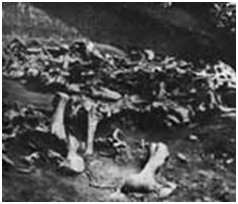
View of mammoth bone ruins excavated at Mezin in the Ukraine Click on the photo for a larger view.
Photo: Secrets of the Ice Age by Evan Hadingham, 1980
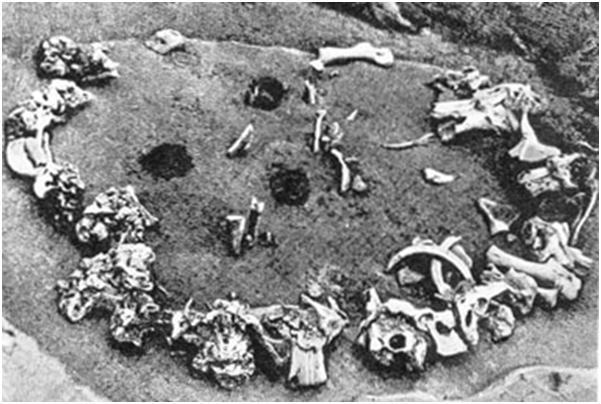
Mezin excavation
Circular hut at Mezin. The fireplaces and vertically standing bones are clearly visible.
Photo: J. Jelinek, 'The Evolution of Man'
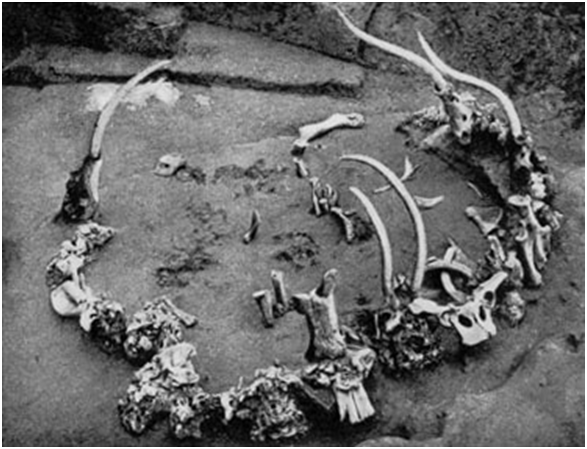
Mezin excavation
Circular hut at Mezin. As an experiment tusks were placed in the upright skulls which formed the outer wall. This demonstrates how the combination could have formed a viable structural unit.
Photo: J. Jelinek, 'The Evolution of Man'
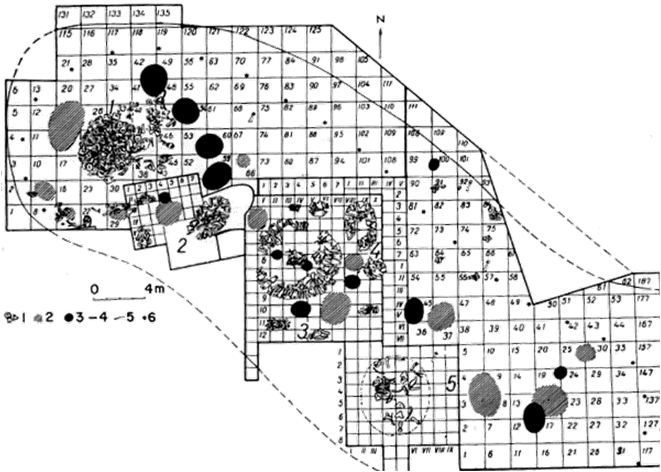
Mezin - plan of the excavation 1, bones; 2, concentration of small objects; 3, hearths; 4, border of excavation; 5, limits of the site; 6, border of the core and periphery areas of the site
Photo: O.Soffer, 'The Upper Paleolithic of the Central Russian
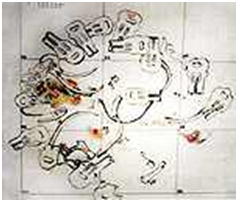
Plain' Plan du pourtour de la cabane n°1 de Mézine d'après le document I. G. Chovkoplass. Relevé des ossements de mammouths ornés d'après L. Iakovleva. Plan of the circumference of the hut n°1 of Mezin according to the document by I G Chovkoplass. Plan of the bones of decorated mammoths according to L Iakovleva.
Photo and French text: "les mammouths - Dossiers Archéologie - n° 291 - Mars 2004" Photograph L Iakovleva. My thanks to Anya for access to this resource.
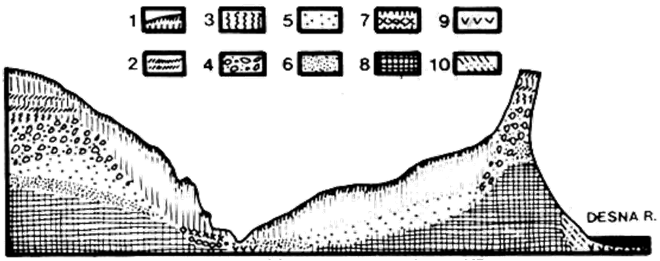
Mezin Cross Section 1, loess and present-day soil; 2, fossil soil; 3, stratified loam; 4, boulder clay; 5, redeposited Paleogene sand; 6, sand; 7, cultural remains; 8, chalk; 9, alluvium; 10, colluvium
Photo: O.Soffer, 'The Upper Paleolithic of the Central Russian Plain'
Mezin, like many other sites on the central Russian plain, was discovered during excavation for a cellar. It was excavated at various times from 1908 to 1961. Its position is at 51 deg 45 min N, 33 deg 05 min E. (From Soffer, Olga, 'The Upper Paleolithic of the Central Russian Plain',1985 ISBN 0-12-654270-8 (alk. paper) ISBN 0-12-654271-6 (pb) ) Soffer says: Cultural remains were located on the left-bank promontory of an old ravine that cut through the interfluve deposits. The ravine is located on the north (right) bank of the river in an area where the interfluve plateau first gently descends to the river and then abuts the river in steep 40-70 m cliffs. The site was open to the south and protected by the plateau to the north. (The site is considered to occupy 1200 square metres) Shovkoplyas also reports finding five storage pits with large bones up to 0.6 m below the level of the hearths outside Dwelling 1. The hearths were a part of the cultural layer, they overlie the storage pits, and are separated from them by a sterile layer of colluvial loess. The promontory on which the cultural layers were deposited is today 10-12 metres above the river, approximately 300 m up the ravine from its entrance into the Desna. Maximal slope of 15 deg to 20 deg for some parts of the living floor is reported... Shovkoplyas explains the absence of a second cultural layer on the level of the storage pits by a rapid downslope erosion that purportedly occurred when man first occupied the promontory - possibly during a spring thaw. The map in Soffer's book shows five mammoth bone houses in a row. Soffer states that bone tools including eyed needles were found at the site, and that portable ivory art included figures variously described as phallic figurines, birds, and abstract representations of the female form. A useful book may be: Pidoplichko, I. H. Upper Palaeolithic dwellings of mammoth bones in the Ukraine: Kiev-Kirillovskii, Gontsy, Dobranichevka, Mezin and Mezhirich. Oxford: J. and E. Hedges, 1998. 276 p. University Museum Library GN414.3.B64 P53 1998 References 1. Hoffecker J., 2002: Desolate landscapes: Ice-Age settlement in Eastern Europe, Rutgers University Press 2. Lister A., Bahn P., 2007: Mammoths: Giants of the ice age, University of California Press 3. Soffer O., Adovasio J., Hyland D., 2000: The 'Venus' Figurines - Textiles, Basketry, Gender, and Status in the Upper Paleolithic, Current Anthropology Volume 41, Number 4, August–October 2000 Крыніца: http://donsmaps.com/wolfcamp.html



